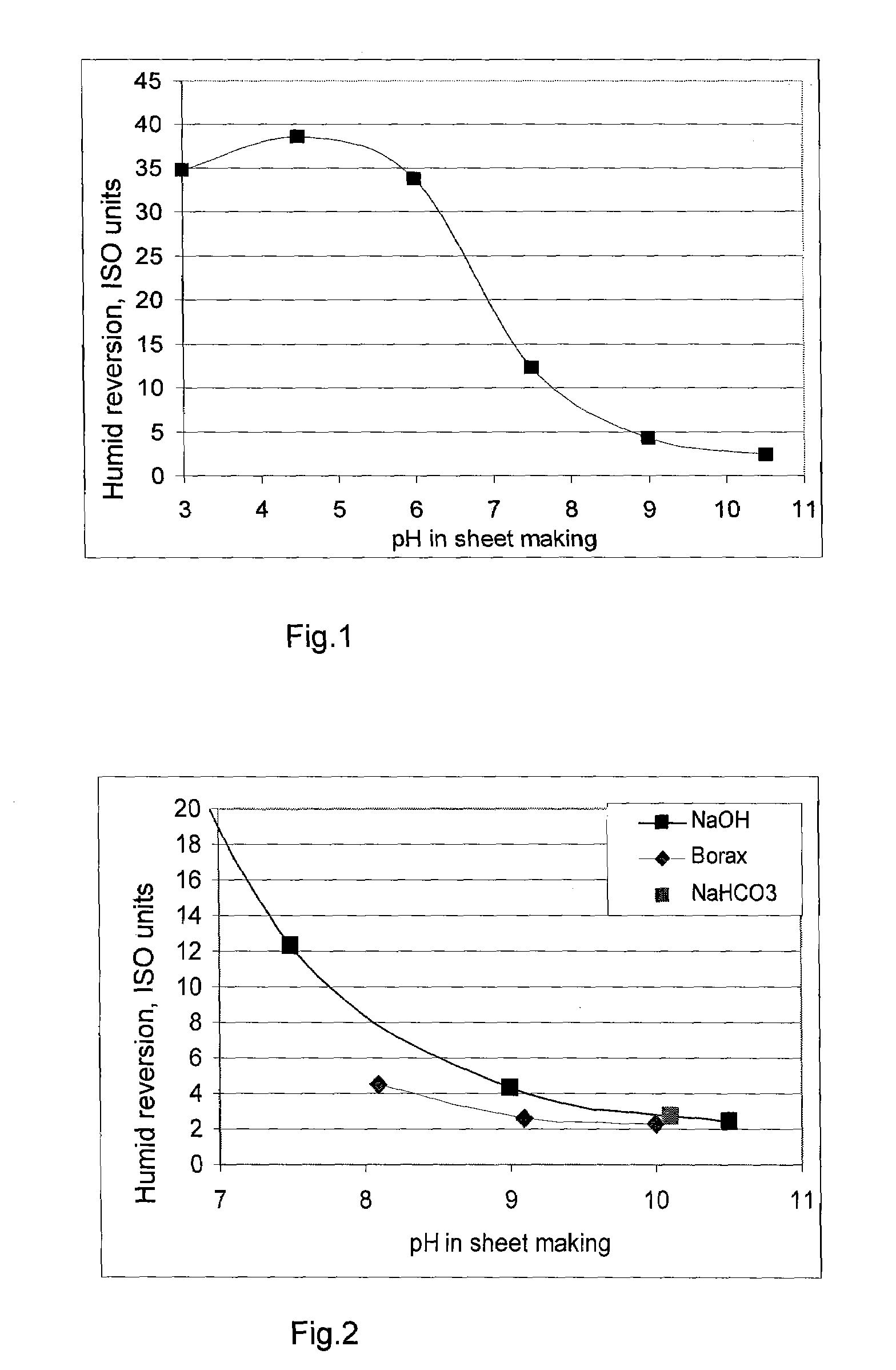Treatment of pulp
a pulp and pulp technology, applied in the field of pulp treatment, can solve the problems of complicated pulp production system, and achieve the effect of improving the brightness stability of bleached pulp
- Summary
- Abstract
- Description
- Claims
- Application Information
AI Technical Summary
Benefits of technology
Problems solved by technology
Method used
Image
Examples
example 1
[0060]In the experiments, sheets were formed from the bleached pulp following the standard ISO method, SCAN-CM 11:95, except that the pH was varied from pH 3 to pH 10.5. The standard method implies to perform sheet forming at pH 5±0.3 (SCAN-CM 11:95). To adjust the pH to the desired levels, H2SO4 or NaOH was used. As can be seen in Table 1 and FIG. 1, humid brightness reversion substantially decreased at an increased sheet forming pH above 6.5.
TABLE 1Sheet forming pH3.04.56.07.59.010.5Brightness88.088.688.889.089.088.8before ageing[% ISO]Brightness after53.250.055.076.784.786.4humid ageing[% ISO]Brightness34.838.633.812.34.32.4reversion[% ISO units]
example 2
[0061]It was also investigated how different approaches to obtain the sheet forming pH affected the humid brightness reversion. The sheets were prepared as in example 1, except that the pH in sheet forming was established using buffers instead of H2SO4 and NaOH. The buffers used were (Borax+NaOH) at pH 8.1, 9.1 and 10.0; and (NaHCO3+NaOH) at pH 10. FIG. 2 shows that high sheet forming pH obtained by use of buffers also results in substantially decreased humid brightness reversion.
example 3
[0062]The experiment was performed using the same bleached pulp as used in examples 1 and 2. The time for dewatering was increased by 20% when increasing the pulp suspension pH from pH 5 to pH 9. A combination of two dewatering agents, i.e. a CPAM (cationic polyacrylamide having a charge of 1.2 meq / g and a molecular weight of about 7,000,000 Dalton) and silica nanoparticles (colloidal aluminum-modified silica having a specific surface area of about 900 m2 / g and an S-value of about 22%) were applied to the pulp suspension at pH 9. The charges were 0.5 kg / t pulp for each dewatering chemical. The time of dewatering was decreased by 20% compared to the reference suspension at pH 5. The results are elucidated in Table 2. Sheets were formed using the resultant pulp after dewatering. The pH was kept at pH 5 and pH 9 throughout the sheeting process. The sheets were subjected to the humid reversion test. The results in Table 2 shows that the time of dewatering is longer at a pH of 9 in the a...
PUM
| Property | Measurement | Unit |
|---|---|---|
| Dimensionless property | aaaaa | aaaaa |
| Dimensionless property | aaaaa | aaaaa |
| Molality | aaaaa | aaaaa |
Abstract
Description
Claims
Application Information
 Login to View More
Login to View More - R&D
- Intellectual Property
- Life Sciences
- Materials
- Tech Scout
- Unparalleled Data Quality
- Higher Quality Content
- 60% Fewer Hallucinations
Browse by: Latest US Patents, China's latest patents, Technical Efficacy Thesaurus, Application Domain, Technology Topic, Popular Technical Reports.
© 2025 PatSnap. All rights reserved.Legal|Privacy policy|Modern Slavery Act Transparency Statement|Sitemap|About US| Contact US: help@patsnap.com



